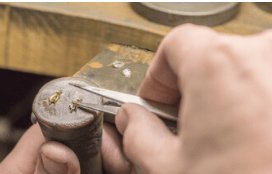Your Cart is Empty
All OUR RING CAN PASS THE DIAMOND TESTER

Wittelsbach Blue Diamond
Wittelsbach blue diamond weighs 35.56 carats, has a color rating of "Fancy Deep Grayish Blue", and VS2 clarity. Its color and clarity are comparable to the "Star of Hope" produced in the same mining area. The Wittelsbach Blue Diamond has a history of at least 350 years and was once the jewel in the crown of the kings of Austria and Bavaria. However, the Bavarian family declined and the diamond was sold in 1951. In 2008, London-based jeweler Lawrence Graff bought the gem at a record price (16.4 million pounds) and cut it himself. After cutting, the gemstone has IF clarity. Now exhibited in the American Museum of Natural History.
Shah Diamond
More than 500 years ago, Indian miners discovered this pure, transparent, yellowish, almost 3cm long diamond. It was later the famous Shah diamond. The Shah diamond weighing 88.7 carats may not be the largest diamond in the world, but it is the only giant engraved diamond in the world.
The diamond is extremely hard, and it is surprisingly difficult to engrave on it. Indian gem craftsmen use a thin stick dipped in some very fine diamond powder method for carving. I don’t know how much time and difficulties it took to engrave a few Persian words on one of its crystal faces: "Burhan-Nicham-Shah second, 1000 (equivalent to AD 1591)". Later, the Great Mughal Emperor engraved the words "Son of Jehang Shah-Jehan Shah, 1051" on another crystal face. Since then, this diamond has been called "Shah". Existing in Russia.
Joseph Grand Duke Diamond
This diamond is about 1.27 cm thick and weighs 76.02 carats, the size of a dove egg. It was once the collection of Archduke Joseph of Austria and has a history of more than 400 years. It was once considered by the gem industry as "one of the most perfect diamonds in history." This D-color diamond has set a record for the highest auction price per carat for a colorless diamond.
After the nineteenth century, the output of the Golconda diamond mine was declining, and rising stars such as Russian diamonds, Botswana diamonds, and South African diamonds have gradually stepped onto the stage of history.
African Star-Cullinan One
The light of our generation (the second largest diamond in the world)-Botswana
People gradually forgot the once beautiful Golconda diamond mine.
However, this mining area was re-lit because of a legend.
In 1870, Russe Convair, who was only 27 years old at the time, heard an Indian legend—(Once there was a rich Persia man named Ali Hafad, he listened to a Buddhist monk telling the story of diamonds and yearned for Endlessly, he started his own journey of looking for diamonds. He went to many, many places without gain. In the end, he threw himself into the river in the Gulf of Barcelona, Spain, with the desire for diamonds and the sadness of finding fruitless. Decades later When Ali Hafard’s son was walking in his garden, he accidentally found a diamond in the stream that the monk said, so he sighed that the diamond was far away from the horizon.)